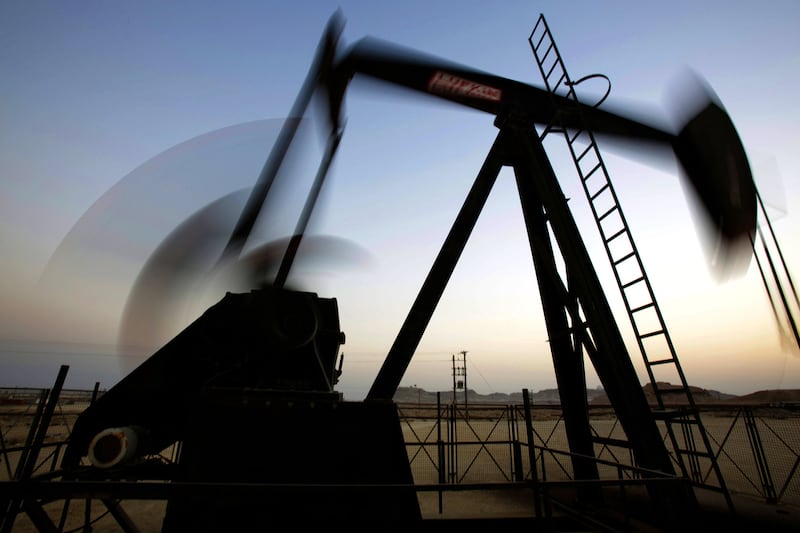Oil prices extended their losses on Wednesday to their lowest levels since March, after the world's biggest benchmarks plummeted 5 per cent a day earlier as a regional banking crisis in the US rattled markets and raised concerns about a recession and lower crude demand.
Brent, the benchmark for two thirds of the world’s oil, settled 4 per cent lower at $72.33 a barrel at market close on Wednesday. West Texas Intermediate, the gauge that tracks US crude, closed down 4.3 per cent at $68.60 a barrel.
Brent settled 5 per cent lower at $75.32 while WTI fell by 5.3 per cent to $71.66 at market close on Tuesday.
The world's biggest benchmarks posted two consecutive weekly declines before this week as a crisis at regional banks in the US led to the collapse of First Republic Bank, the second-largest failure in US history since the 2008 global financial crisis when Washington Mutual imploded.
“It got ugly a lot faster than any oil trader expected … oil is in the danger zone as the banking crisis is crippling the short-term outlook for the economy and driving fears that we could be recession-bound a lot faster,” said Edward Moya, a senior market analyst at Oanda.
“Oil, basically, has weakening prospects from the world’s two largest economies, China and the US, and if the macro backdrop deteriorates, momentum selling could easily send prices below the $70 level.”
The US has had three other failures this year that include Silicon Valley Bank, Signature Bank and cryptocurrency-focused lender Silvergate Capital.
The financial turmoil has raised concerns about credit conditions in the US, which are expected to deteriorate for consumers and businesses over the coming six months to their worst level since the Covid-19 pandemic, a survey of chief economists at 15 of America's biggest banks showed last month.
The American Bankers Association said its Credit Conditions Index fell to 5.8 in the second quarter, from 12.5 in the first quarter. A reading below 50 indicates that the economists forecast weaker credit conditions in the coming six months.
Mixed economic data from the US and China, the world's two largest economies, has also added to the uncertainty about the outlook for oil, dragging prices lower.
China is the world’s top importer of crude, and the decline in oil prices also partly reflects disappointment over survey data pointing to the contraction in Chinese manufacturing activity since December, UBS said in a research note.
In an interview with Bloomberg TV on Wednesday, Amrita Sen the co-founder and director of research at Energy Aspects, said concerns over a slowdown in China are "overblown" and that the productions cuts of Opec+ announced last month need time to materialise.
The US Federal Reserve raised interest rates by 25 basis points on Wednesday, its tenth increase since March 2022 as it aims to bring inflation down to its 2 per cent target rate and restore price stability after consumer prices hit a 40-year high of 9.1 per cent in June last year.
The interest rate increase is expected to put further downward pressure on crude prices and is raising concerns that further monetary tightening will push the US economy into a recession and dent demand.
The "bump raise in the rate has been a factor in the oil price retreat in the past week, as the market has priced in a stronger dollar and downside pressure on oil”, said Rystad Energy senior analyst Louise Dickson.
“The excess money supply in the US market still holds some upside potential for oil prices but any signal of a 'higher for longer' outlook from the Fed on interest rates holds further downside risk for oil prices in the short term.”
The Fed continues to face a delicate balancing act, as it considers the reverberations of further tightening to fight inflation against the backdrop of the turmoil in financial markets.
While inflation in the world's largest economy has come down, it remains high, with the annual Consumer Price Index for March slowing to an annual 5 per cent from 6 per cent in February, well above the Fed's 2 per cent target rate.
Some critics have blamed the Fed for acting too slow and playing catch-up with inflation, which was initially considered transitionary.
Others have attacked the US central bank for its subsequent aggressive pivot in which it raised interest rates by a series of 75 basis point and 50 bps increases, stoking fears and criticism that overtightening may increase the risk of a recession.
The Fed needs to increase unemployment in the US economy and reduce money supply to reduce inflation. While thousands of jobs have been shed, the labour market remains tight.
“There is still a significant amount of excess money supply in the US economy that needs to be fully absorbed in goods and services, which means that prices will still be pushed higher and that the Fed’s medicine may need to be administered at a higher dose for a longer duration,” said Ms Dickson.
The US economy slowed to an annual 1.1 per cent in the first quarter of this year after expanding by an annual 2.6 per cent in the previous quarter.
“Stability of the banking system is a primary duty of any central bank. By raising interest rates, the Fed would risk putting the commercial banking sector under further strain, with the potential of more regional banks collapsing,” Ms Dickson said.
Curbing inflation and the appreciation of the US dollar over the past year puts downside pressure on oil prices as crude becomes more expensive for importing countries with weaker currencies than the dollar.
Ms Dickson said while the focus now is on the US dollar and Fed policy, “a bigger monetary risk lurks in mainland China, which could decide to ‘loosen’ its money supply by deflating its currency in a bid to stimulate its export-driven economy, which could prove deflationary overall for global economic growth”.







